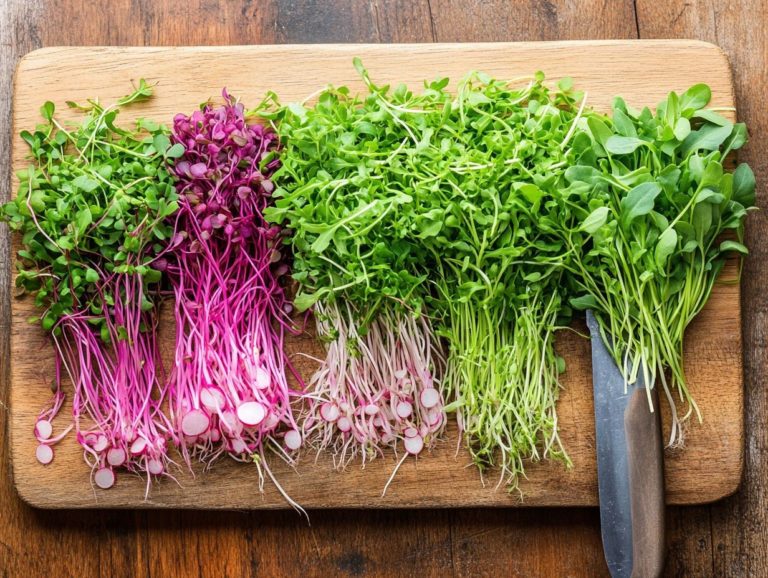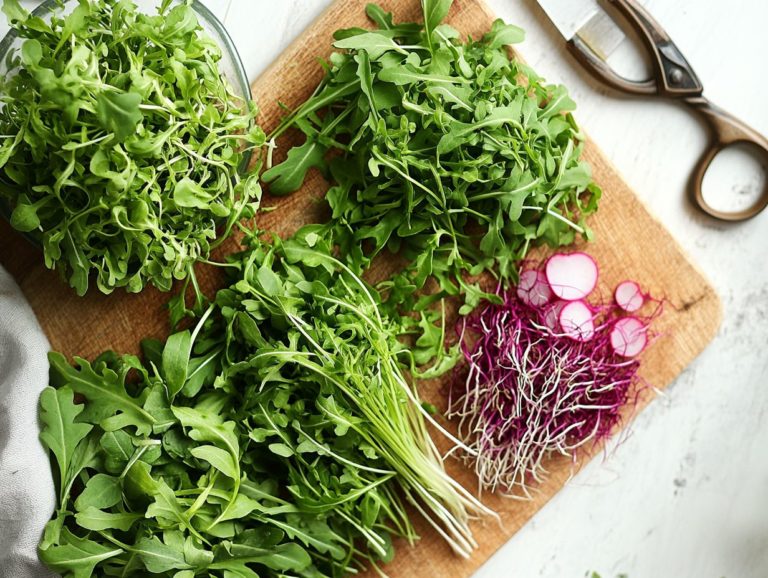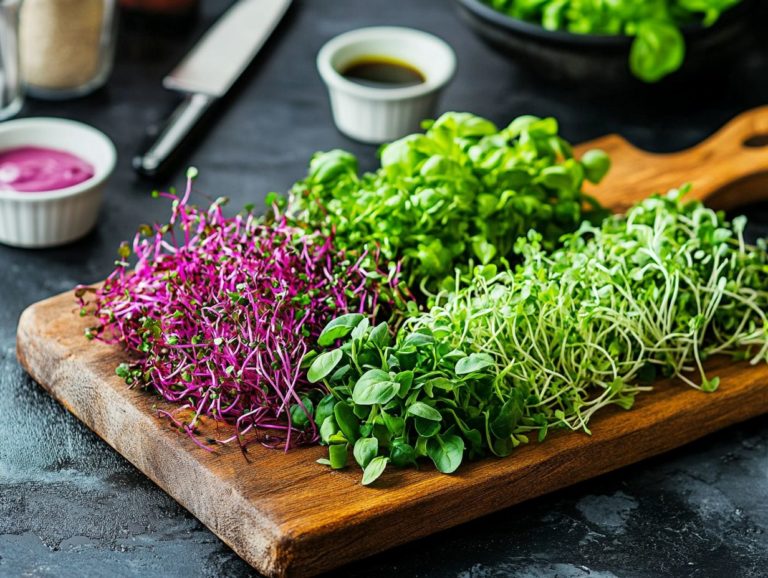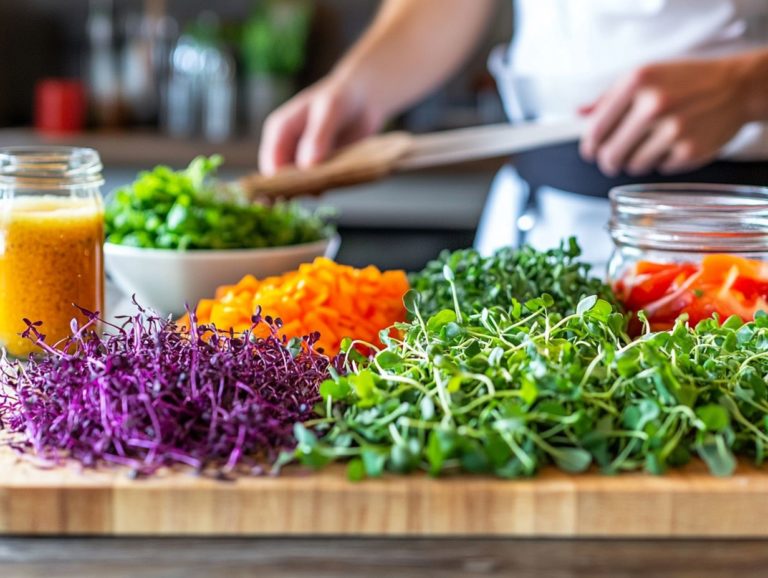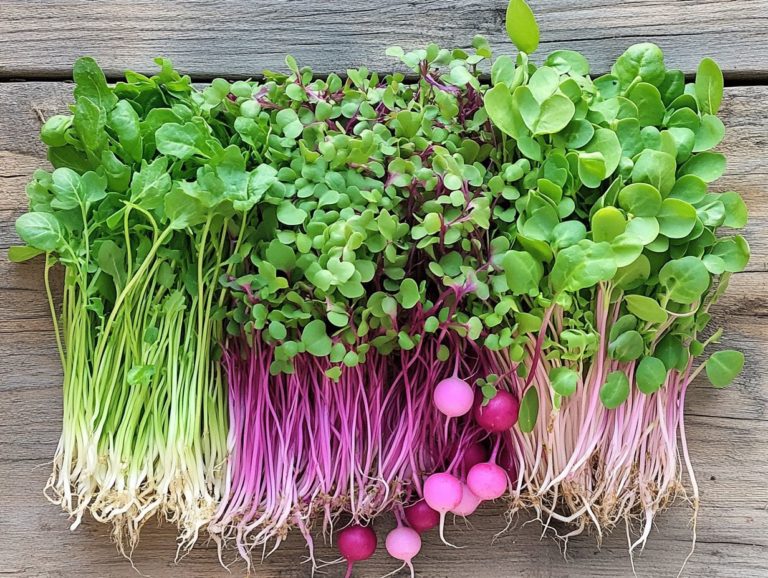How to Choose Microgreen Varieties for Your Garden
Join the microgreens revolution! These small plants can turn your meals into culinary masterpieces and boost your health. Microgreens are small, rich in nutrients plants that are becoming increasingly popular for their culinary versatility and impressive health benefits.
Whether you re an experienced gardener or just dipping your toes into the world of gardening, cultivating microgreens can elevate your meals and enhance your nutrition, leading to healthier eating habits. You will also find a step-by-step guide for growing them at home, along with solutions to common challenges, including the best gardening tools to ensure that your journey into the realm of microgreens is both enjoyable and rewarding.
Contents
- Key Takeaways:
- Benefits of Growing Microgreens
- Factors to Consider When Choosing Microgreen Varieties
- Popular Microgreen Varieties and Their Uses
- How to Grow Microgreens at Home
- Troubleshooting Common Issues with Microgreens
- Frequently Asked Questions
- Wondering what microgreens are?
- How do I choose the right microgreen varieties for my garden?
- What are some popular microgreen varieties to grow in the garden?
- Can I mix different microgreen varieties together?
- How do I know when my microgreens are ready to be harvested?
- Are there any microgreen varieties that are easier to grow for beginners?
Key Takeaways:
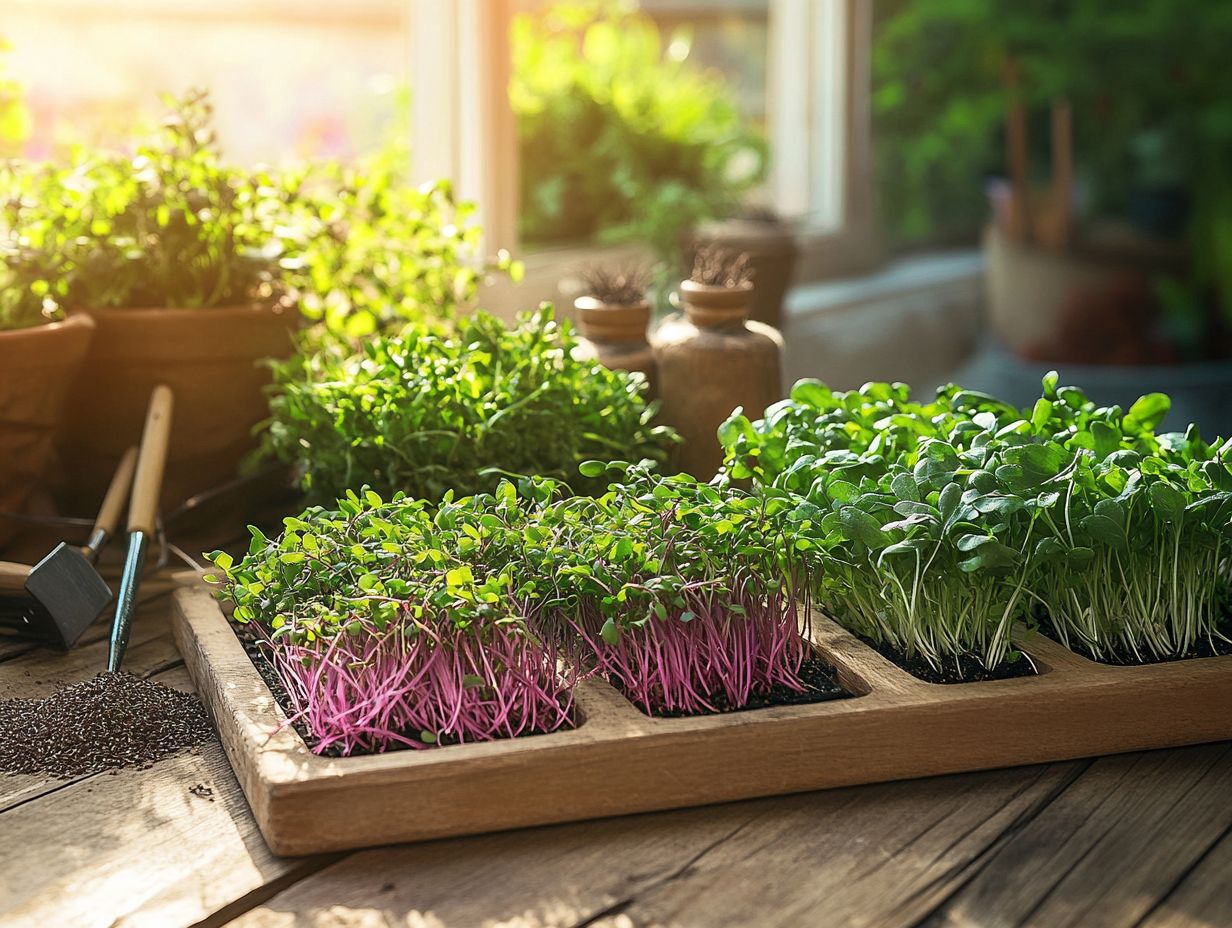
- Choose the right microgreen varieties based on your climate.
- Consider your flavor preferences to enhance your dishes.
- Explore popular microgreen varieties such as broccoli, radish, and sunflower, each with unique flavors and culinary uses.
What are Microgreens?
Microgreens are delightful little edible plants you harvest early on. They are brimming with flavor and nutrients, appealing to health-conscious individuals. Varieties like Arugula, Kale, and Broccoli shine with their vibrant colors and diverse tastes, earning their spot as superfoods in your kitchen.
You can easily grow them at home, making it simple for you to elevate your diet with fresh vegetables while embracing a sustainable lifestyle.
Beyond their eye-catching appearance, microgreens offer an impressive nutritional profile, often packing higher concentrations of vitamins and minerals than their mature counterparts. Imagine adding Radish microgreens for a peppery kick or Beet microgreens for a touch of earthy sweetness each one allows you to explore a range of tastes and textures in salads, sandwiches, and garnishes.
Their versatility is further enhanced by the wide variety of seeds available, such as Basil, Mustard, and Sunflower, each contributing its unique flavor notes and health benefits to your culinary creations. With such a rich profile and the ease of cultivation, it s no surprise these miniature greens are becoming staples in both home kitchens and upscale restaurants.
Benefits of Growing Microgreens
Growing microgreens presents a wealth of benefits, elevating your nutritious diet while offering a hassle-free gardening experience, even if space and time are at a premium. These small yet powerful plants pack a punch in health benefits and require minimal effort and resources to cultivate, making them a perfect addition to your home garden or kitchen countertop.
With delightful varieties like Mustard, Sunflower, and Cilantro, embarking on the journey of growing microgreens is not just practical; it s a truly rewarding and fulfilling endeavor.
Nutritional Value and Convenience
Microgreens are celebrated for their remarkable nutritional value, boasting higher concentrations of vitamins and antioxidants substances that help protect your cells from damage than their mature counterparts. This makes them a favored choice among superfoods. Their quick growth cycle provides an ongoing supply of fresh greens, ideal for effortlessly enhancing salads and other dishes and making them easy to grow.
Easily integrated into any diet, these tiny powerhouses not only elevate your meals but also promote healthier eating habits. Among the standout varieties, Alfalfa microgreens deliver a significant nutritional punch with abundant vitamins A, C, and K, as well as essential minerals like calcium and iron, making them an excellent addition to a health-conscious kitchen.
Radish microgreens are rich in vitamin E and a plethora of phytochemicals that support overall well-being and enhance healthy eating. The beauty of growing these nutrient-packed greens at home whether in soil, hydroponically, or even in a simple jar renders them accessible to everyone. Just sprinkle a handful onto your sandwiches or blend them into your smoothies, and you can effortlessly boost your daily nutrient intake without breaking a sweat, highlighting their versatility in cooking with microgreens.
Ready to start your microgreens journey? Grab your seeds today and enjoy fresh greens at home!
Factors to Consider When Choosing Microgreen Varieties
Choosing the right microgreen varieties is essential for successful growth and optimal flavor. Think about the types that match your environment and personal taste.
A solid understanding of growing conditions like light, temperature, and humidity will greatly influence your microgreens success. Explore the unique flavors and textures of greens like Cress and Borage to elevate your cooking.
Climate and Growing Conditions
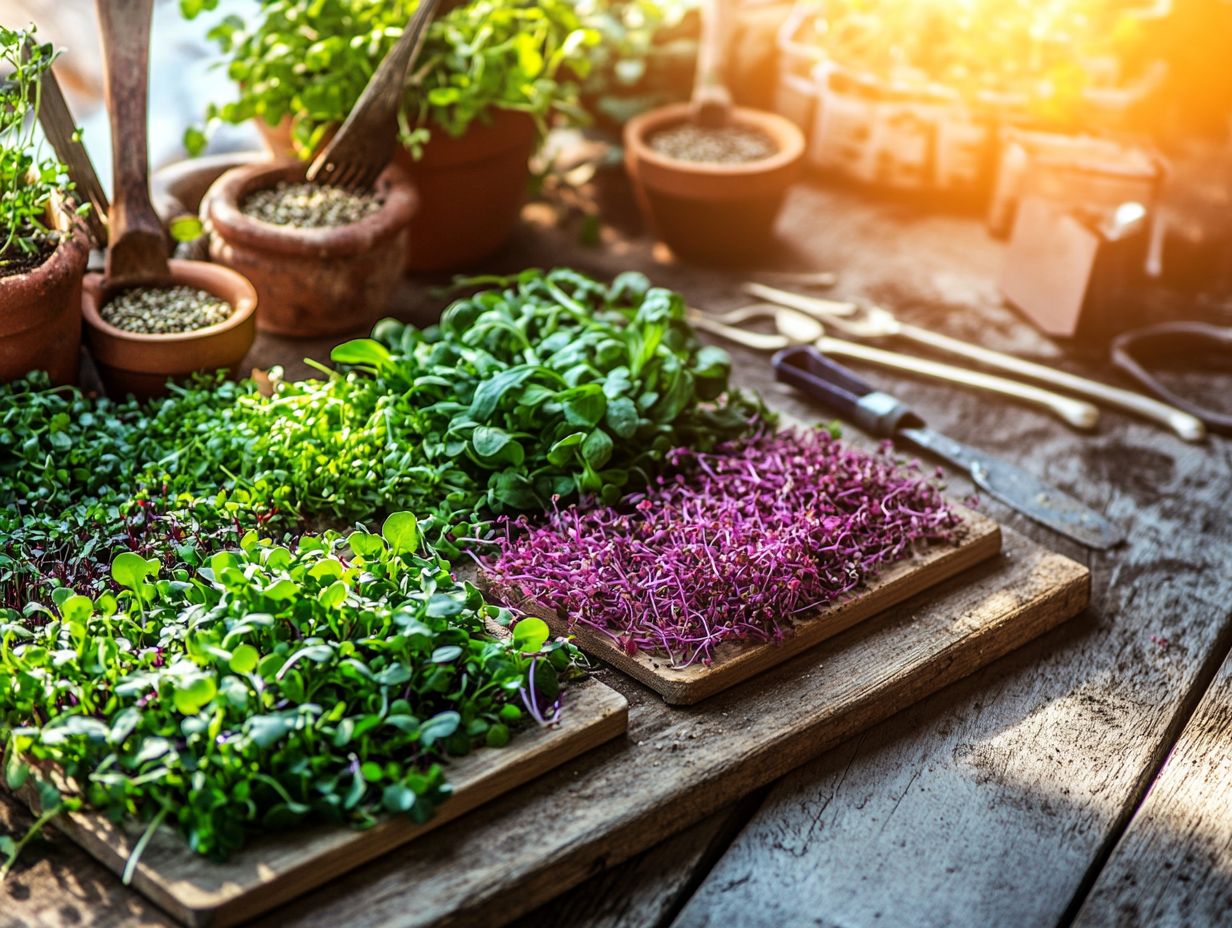
The climate and conditions are vital for growing microgreens. Indoor spaces provide the perfect setting for consistent growth, regardless of outside weather.
Pay close attention to light exposure, temperature, and humidity levels. They significantly influence the health and yield of your microgreens.
Careful monitoring of watering practices is crucial. Over or under-watering can harm your plants.
Selecting the right growing medium is also vital. It should provide nutrients and good drainage for root development.
Light is another key factor; microgreens thrive under bright, indirect light. Fluorescent or LED grow lights work well indoors.
Keep humidity levels around 40-60% to prevent issues like mold. This keeps your plants healthy.
Adopt proper watering techniques like using a gentle spray or bottom watering. This prevents soil compaction and ensures proper moisture levels.
Flavor and Taste Preferences
Flavor is crucial when selecting microgreens for cooking. Different varieties offer unique flavors and textures. Enjoy the mild sweetness of Pea shoots or the kick of Mustard and Radish.
By understanding each microgreen’s characteristics, you can transform your dishes into gourmet experiences filled with vibrant flavors. A variety of greens creates visually stunning plates that suit different tastes.
Imagine the sweet crunch of Basil microgreens in a fresh tomato salad or the peppery zest of Arugula microgreens in a sandwich. Experiment with Cilantro microgreens to add depth to guacamole or salsa.
Microgreens aren t just about taste; their vibrant colors and delicate textures enhance presentation, making every dish feel special. Be creative in the kitchen for mouthwatering discoveries!
Popular Microgreen Varieties and Their Uses
Exploring popular microgreen varieties reveals a stunning array of flavors and culinary possibilities. They can elevate everyday meals into extraordinary dining experiences.
Varieties like Basil, Cilantro, and Sunflower microgreens bring visual flair and enhance flavors in salads, sandwiches, and garnishes.
Understanding these microgreens’ unique characteristics allows you to unleash your creativity and seamlessly choose the right soil for microgreen growth to add fresh greens to your meals.
Common Types and How to Use Them
Common types of microgreens, like Alfalfa, Chard, and corn, each bring their own unique flavors, textures, and culinary potential to your table. These nutrient-packed greens are not just for decoration; they can transform your dishes into colorful masterpieces, earning them the title of vegetable confetti.
By mastering the art of incorporating microgreens into your meals, you can elevate your dining experience and leave your guests in awe with your creative flair.
Taking a closer look at their distinct qualities, Alfalfa microgreens offer a subtle, nutty flavor that perfectly complements sandwiches and wraps. Then there s Chard, with its bright, earthy taste, which pairs beautifully with savory dishes like grain bowls and omelets, adding both flavor and a vibrant splash of color.
Lastly, Corn microgreens bring a sweet, delicate note, making them an ideal topping for tacos or a fresh addition to salsas.
Incorporating these lively greens into your cooking not only ramps up the visual appeal of your meals but also enriches them with essential nutrients, aligning perfectly with a healthful lifestyle.
How to Grow Microgreens at Home
Growing microgreens at home offers a rewarding experience that requires minimal space and effort. This makes it an ideal pursuit for both novice microgreen growers and seasoned gardening enthusiasts.
With the right tools, microgreens kits, and optimal growing conditions, you can cultivate your own nutrient-rich greens right on your kitchen countertop or balcony.
From sowing seeds to harvesting your microgreens, every step in the process brings a profound sense of accomplishment and a delightful connection with nature.
Step-by-Step Guide to Growing Microgreens
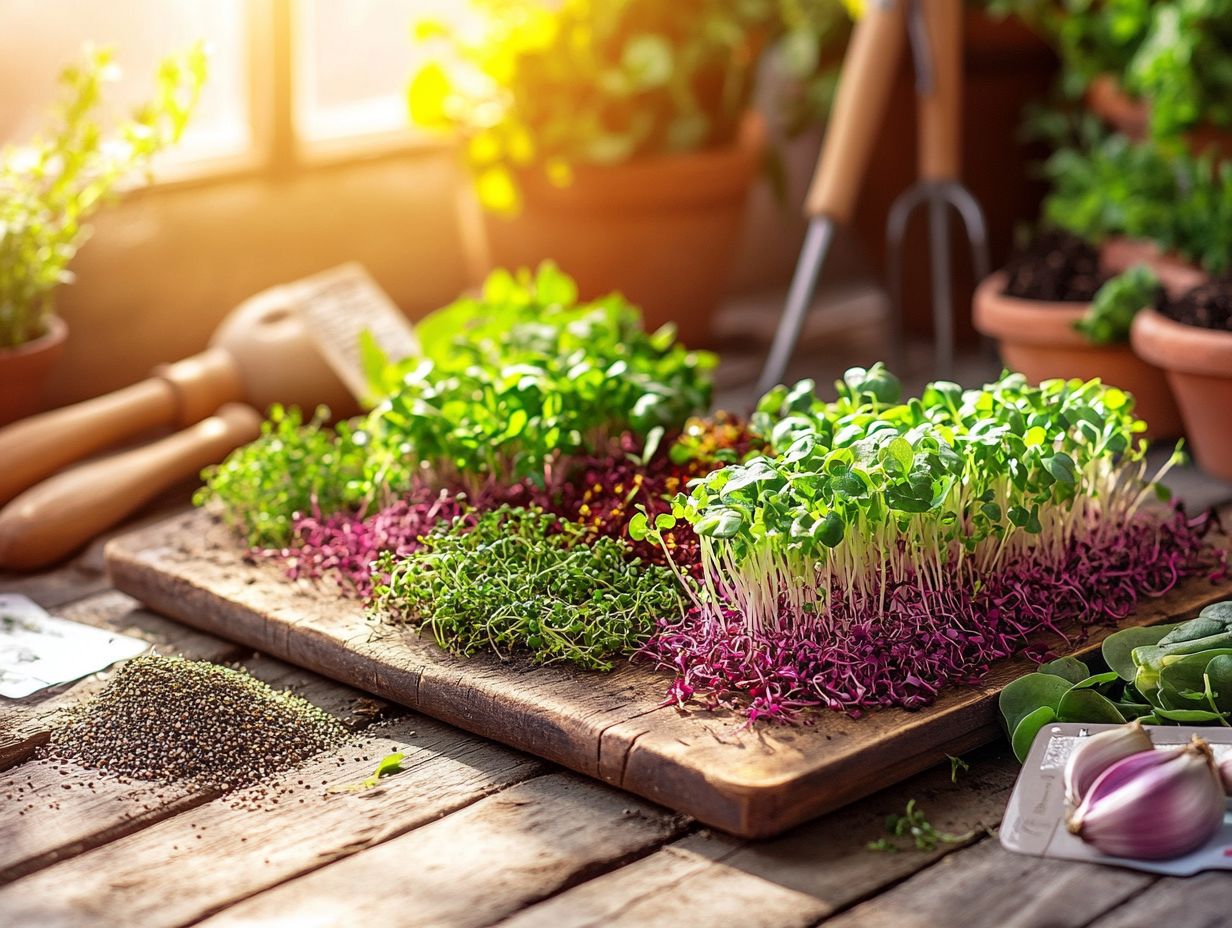
To successfully grow microgreens, start by selecting your preferred microgreen seeds and preparing the right growing medium think seed starter mix or quality soil. Sow the seeds evenly across the surface, giving them enough space to flourish.
Next, establish a consistent watering routine. Keep the medium moist but not soggy; this keeps your seeds happy and sprouting!
Now, consider the light exposure. Microgreens thrive in bright, indirect sunlight or under grow lights for about 12-16 hours a day. This ensures robust growth and vibrant flavors that will elevate your culinary creations.
Once your seedlings reach about two to three inches in height, it’s time to focus on harvesting. Cutting them at this height gives you the best flavor and nutrition. For optimal taste, clip the microgreens just above the soil line, and rinse them gently before consuming. This thoughtful approach rewards you with fresh, nutritious greens ready to enhance any dish.
Troubleshooting Common Issues with Microgreens
Troubleshooting common issues with microgreens is vital for ensuring a successful and abundant harvest, particularly for those just starting out in gardening.
Challenges can stem from inadequate growing conditions, pest infestations, or improper watering techniques, all of which can impede the growth of popular varieties like Kale, Arugula, and Radish microgreens.
By identifying these problems early on, you enable yourself to make informed adjustments to your growing medium and care practices. This sets the stage for optimal results.
Get started with your own microgreens today!
Identifying and Solving Problems
Identifying and solving problems in microgreens cultivation is essential for ensuring that your plants thrive until harvest. You might encounter common issues such as yellowing leaves, stunted growth, and unwanted pests. However, with vigilant monitoring and care, you can tackle these challenges head-on! By recognizing the signs of distress in your microgreens, swiftly implement pest control measures or adjust your growing conditions to set yourself up for a successful harvest.
Maintaining optimal light conditions, humidity levels, and soil quality is crucial to preventing these issues from cropping up in the first place. For instance, overwatering can lead to root rot, which means the roots have become unhealthy due to too much water. This comes with a nasty smell and mushy roots definitive signs of excess moisture. Combat this by ensuring proper drainage and watering only when necessary to minimize the risk.
Regularly inspecting your plants for pests, such as aphids or fungus gnats, is equally crucial. Detect pests early to take action quickly! Using natural pest control methods, like neem oil, can effectively handle infestations while keeping your growing environment safe.
With consistent attention and the right strategies, cultivating microgreens is not just manageable but genuinely rewarding. Start growing your own microgreens today!
Frequently Asked Questions
Wondering what microgreens are?
Microgreens are young, tasty greens that pack a nutritional punch! They are harvested when they are only a few inches tall and are packed with nutrients. Growing them in your garden allows you to have fresh and healthy greens at your fingertips.
How do I choose the right microgreen varieties for my garden?
The first step in choosing microgreen varieties is to consider your taste preferences and intended use. Different varieties have varying flavors and textures, so think about what you would like to add to your meals. You should also consider the climate and growing conditions in your area, as some varieties may thrive better than others.

What are some popular microgreen varieties to grow in the garden?
Some popular microgreen varieties include arugula, broccoli, radish, pea shoots, and sunflower. These varieties are easy to grow and can add a burst of flavor to salads, sandwiches, and other dishes. They also have a short growing cycle, so you can harvest them in as little as 7-10 days.
Can I mix different microgreen varieties together?
Absolutely! Mixing different microgreen varieties can create a unique blend of flavors and textures. Just make sure to choose varieties that have similar growing conditions, such as sun exposure and watering needs.
How do I know when my microgreens are ready to be harvested?
Microgreens are ready to be harvested when they have developed their first set of true leaves, which typically happens within 7-14 days after sowing. You can also taste a few to see if they have reached the desired flavor and texture.
Are there any microgreen varieties that are easier to grow for beginners?
Yes, some microgreen varieties are easier to grow for beginners, such as arugula, broccoli, and radish. These varieties have a higher success rate and are more forgiving when it comes to growing conditions. They are also quick to germinate and grow, making them a great option for beginners.

